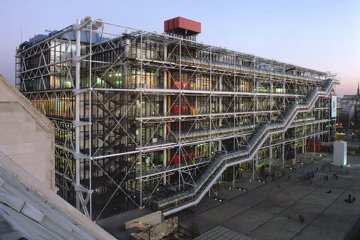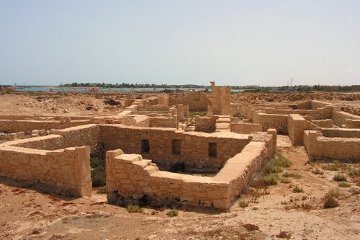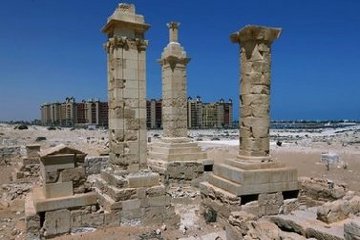Leukaspis
| Leukaspis | 30 49 24.81N 29 00 43 .83E | Some of the excavated buildings can be clearly seen, though the major buildings - like temples and theatres - are not visible in this view. |
| Timgad | 35 29 01.23N 06 28 01.27E | The entire layout of the walled city can be clearly seen in this aerial view. In fact, many of the houses look as if they could be lived in again with minimum repairs! |
Modern all-glass buildings would appear to pose many problems - not least that of safety for anyone higher than the ground floor. What happens if you trip, as you approach your desk thirty-seven stories up, and crash against that glass wall? To an acrophobic like myself, even the thought is enough to cause my heart to beat faster and the tale of the show-off who repeatedly hurled himself against such a glass panel in order to demonstrate its strength, only to have it give way eventually, smacks of poetic justice, if not outright divine vengeance on the sin of presumption!
To an architect with confidence in his mastery of modern materials, however, such considerations are minor. Of far greater importance - and even more problematic - is the question of what do you do with the pipes? Back in the days of Ictinus, Callicrates, and Phidias, the Greek architects who designed the Parthenon in Athens, all you had to do was design the building with due regard to the Golden Mean and the principles of aesthetics. Then came the invention of plumbing and architects were faced with the difficulty of maintaining a sense of beauty both inside and out while finding somewhere to put the pipes - both those that supplied the water and those that carried it away.
Then came gas, followed shortly by electricity and suddenly it became impossible to think of a building that did not have pipes and wires festooning every space and trailing over every surface. I can remember, as a boy with the measles, lying in bed and tracing the electric wires which, mounted on little wooden pathways, ran from the switches on one side of the room up across the ceiling to the lights, the fan, the fridge and the two-pin power point into which those wealthy enough to have portable appliances could plug them in. As complex as any national railway system, the wiring of the house provided endless entertainment for someone with a love for trains and a vivid imagination!

| |
| The Pompidou Centre in Paris, whose exterior pipe work gives it all the prize-winning appeal of a building site where the workers have gone on strike. |
Eventually, of course, wires were hidden beneath the plaster of the walls, both for safety and for visual aesthetics, but no sooner were the mains hidden away with a discreet double socket located behind the sofa than along came computers and the need for data cables and additional sockets and televisions with multiple play-back devices (which also needed additional sockets) and the complexity of all these services swiftly assumed mind-boggling dimensions. (In Britain - and Europe generally - we also have hot-water central heating, with more pipes and cables to be routed through the house and discreetly hidden from view.)
It is no wonder that the Italian architect, Renzo Piano, faced with the challenge of wiring and piping a huge "cultural centre" in the heart of Paris just gave up on the whole thing and decided to make the pipes and conduits a feature of the building. Rather than spend sleepless nights trying to make the wires and pipes invisible in his glass shoebox, he ostentatiously draped them over the outside of the building and, I am sure, was vastly astonished when not only was his design accepted, but a world always avid for something new and different gave him an award for the design!
He wouldn't have got far in ancient Leukaspis, where the architects of the time faced a somewhat similar problem. Located on the coast of Egypt, there were no rivers or springs nearby to be tapped by a grand Roman aqueduct marching across the landscape. Instead the residents relied upon the winter rains that were harvested from the house roofs and channelled down into cisterns beneath the buildings. The only problem was the channelling.
The architects could, if they wished, have festooned the houses in lead pipes, but not only was lead expensive and therefore attractive to thieves, but the dark lines of lead piping would have detracted from the pristine whiteness of the limestone buildings and marred the classical lines of their architecture. The solution was simple: every house worthy of the name had a courtyard lined with pillars: the architects hollowed out the pillars and used them to pipe the rainwater down into the below-floor cistern!
Household waste water - and the little rain that didn't make it into the cisterns, was channelled away by a sophisticated sewer system running beneath the streets and leading into the nearby sea.
These details are only gradually coming to light, for until the 1980s this was a barren area of coast, site of the World War II battle of Alamein. As tourism boomed after twenty years of peace under President Hosni Mubarak (a point worth remembering at a time when he is being villified for his over-long hold on power) and prosperity began its slow trickle down to the lower levels of society, middle class Egyptians began to wonder whether the mad infidels weren't onto a good thing in the hedonism of sun, sea and sand. More and more of them wanted their own resorts and property developers on the outskirts of Alexandria began to view the desolate shoreline through greedy eyes.

| |
| The recently excavated ruins of Leukaspis, a prosperous Roman town on the coast of Egypt. |
In 1986 Chinese engineers started work on a network of roads to serve the new resort that was springing up just to the east of Montgomery's old battle ground. Almost at once they discovered the remains of tombs and houses and reluctantly called in the antiquities authorities. A preliminary survey quickly established that the remains were Roman and dated from the second century BC to the fourth century AD. Literary evidence suggested that the newly discovered town was ancient Leukaspis or Antiphrae, a prosperous port city with links to Crete.
Four years later a team of Polish archaeologists began to work in Leukaspis and have continued to work there till the present. Somewhat grudgingly, the developers gave up 200 acres at the east end of their new resort of Marina, an action which the Poles both appreciate and resent, for their excavations point down to the ancient harbour - which no longer exists! In the late 1990s the developers constructed an artificial lagoon (clearly visible in the Google Earth image referred to above) and used vast quantities of dynamite to blast out the new water feature. What no one realised at the time was that the eastern end of this lagoon is the site of the ancient harbour and whatever sunken ships or discharged cargo lay in its silted up remains are now lost forever.
The Poles estimate that in its heyday, Leukaspis held some 15,000 residents and made its living by exporting grain, livestock, wine and olives - a fact which indicates that the hinterland was not always the barren waste of sand and rock that it is today! The wealthy merchants lived in elegant two-storey villas built around a pillared courtyard which provided not only shade and coolth, but a private dwelling and working space where women could live undisturbed by the outside world.
Buildings that have been identified include a basilica which was converted into a church as Christianity triumphed, a bath house, and a bench-lined portico that was probably used for meetings of the city council.
Unlike other cities along the north African coast, which gradually died as the Roman world crumbled and the process of desertification intensified, Leukaspis disappeared virtually overnight. In AD 365 there was a massive earthquake off the coast of Crete which triggered a tsunami that swept across the Mediterranean and smashed ashore here. Alexandria, 80 miles up the coast, was also affected but through some vagary of underwater topography, the wave was particularly devastating at Leukaspis. The evidence of destruction can be clearly seen in the ruins and the few survivors appear not to have returned but to have gone as refugees to nearby cities such as Alexandria.

| |
| Three of the unique pillar-tombs of Leukaspis with buildings of the modern resort in the background. |
Among the structures destroyed are the unique pillar-tombs which have now been restored - though the bodies which once lay in them have long since disappeared. Other tombs are also being cleared and prepared for the tourists that the government hopes will flock to the area. Curiously, down at the bottom of the tomb shafts the archaeologists have found rusty tins of bully beef and other military items, indicating that British and Australian soldiers took refuge in these convenient holes from the German bombs and shells. One wonders what they made of the scattered ribs and skull fragments of the original occupants of the tombs!
the barren waste You may have read of rock pictures - petroglyphs - found in the Sahara depicting hippopotami and other water creatures. These are regularly cited as proof that in the far distant past the Sahara was a fertile, well-watered savannah teeming with wild life, rather like the plains of Kenya today. The evidence seems clear to me that that "far distant past" wasn't all that far distant! In fact, it is highly probable that it was human action that severely modified the Mediterranean climate, producing the arid or even desert conditions of today.
After all, north Africa was once regarded as the breadbasket of ancient Rome and the remains of substantial Roman cities at places like Timgad bear witness to the agricultural importance of countries like Algeria and Libya, which today survive on oil alone. Return
© Kendall K. Down 2011





